状语从句表格整理.pdf
状语从句连词表格

状语从句时状语从句连词引导从句的连词备注after, as, before, once, since, till, until, 1.hardly, no sooner 引导的从句要用过去完成时态,hardly 和 no sooner 在句首时,从句要部分倒装.Hardly had sb. done sth.+when/before... ;No sooner had sb. done sth. +than...间状语从句地点状语从句方式状语从句原因状语从句结果状语从句目的状语从句条件状语从句when,whenever,while,as soon as,hardly(scarcely)⋯ when,No sooner ⋯than, the time (moment, instant,minute, day ⋯ ),immediately,instantlywhere , whereveras, as if/thoughbecause, since, as, now (that)so ⋯ that,such (a)⋯that,so that,thatso that, in order thatif , unless, in case , as/as long as, only if,on (the)condition that,suppose/supposing(that),provided/providing (that)2.since 引导的从句注意看动词是瞬间动词还是延续性动词.Since句型 : It is /has been+time since sb+ 过去时态3.when 引导的从句注意其特殊用法.was about to do/was on the point of doing/was doing/had (not) done+when(就在那时)...4.before 的句型It will ( not ) be +time+before It was (not)+time before5.not ⋯ until 的在倒装句中和强调句中Not until+ 副词 / 介词短语 / 状语从句 +半倒装; It was not until+ 被强调部分 +that+句子其它部分后者表示强调 .as“按照”;“正如”语气一个比一个弱; for“因为”,引导的是并列句,表示非常明显的原因或者是作为推测的理由,但它只能位于句末. It must have rained last night, for the ground is wet. (推测的理由)The six blind men had never seen an elephant, for they were blind. (非常明显的原因)so ⋯ that和 such...that 中的 so 或 such 在句首,主句要部分倒装.So+形容词 / 副词 +半倒装 +that...so that 也可以引导结果状语从句“以至于...”注意分清 if 从句中是否该用虚拟语气.only if 位于句首 ,主句倒装比较状语从句让步状语从句as ⋯ as ;not so ⋯ as; the same as;such ⋯ as; thanthough, although, even though, as,while (“尽管”,只在句首) , nomatter how/wh-= -everHenry is not such a good worker as Peter .as 引导的让步状语从句要倒装; though 引导的让步状语从句可以倒装也可以不倒装名词 / 形容词 / 副词 / 动词原形 +as/though+ 主语 +谓语, +主句 .。
状语从句表格

状语从句
种类
连接词
注意点
时间状语
when, whenever, while, as, before, after, until, till, , as soon as
主句表示将来意义时,从句须用一般现在时;
while引导的从句中动词一般源自延续性的;until用在肯定句中主句动词是延续性的,而否定句中主句动词为短暂性的。
比较状语
than, as…as, not so/as…as, the more…the more
The more exercise you take, the more healthier you will be.
让步状语
though, although, even if, even though, as, no matter what, whatever, no matter who, whoever, no matter which, whichever, no matter how, however, no matter when, whenever
主将从现,if引导的那句叫做从句(if 翻译成如果时)
目的状语
so that,in order that,for fear that(恐怕)
so that和in order that后常接may, should, could, would等情态动词
结果状语
so…that, such…that
如此。。。。以至于导致了一种结果,所以叫结果状语从句
I will wait till my mother comes back.(肯定句时用延续性动词)
原因状语
because, since,as,now that(既然)
状语从句连词表格

状语从句 时 间 状 语 从 句
地点状语 从句 方式状语 从句 原因状语 从句
结果状语 从句
引导从句的连词
备注
after, as, before, once, since, till, until, 1.hardly, no sooner 引导的从句要用过去完成时态,hardly 和 no sooner 在句首时,从句要部分倒装.
so that 也可以引导结果状语从句“以至于。。。" 注意分清 if 从句中是否该用虚拟语气. only if 位于句首,主句倒装
Henry is not such a good worker as Peter . as 引导的让步状语从句要倒装;though 引导的让步状语从句可以倒装也可以不倒装 名词/形容词/副词/动词原形+as/though+主语+谓语,+主句。
when, whenever, while, as soon as, hardly Hardly had sb。 done sth.+when/before... ; No sooner had sb。 done sth. +than..。
(scarcely) … when,
2.since 引导的从句注意看动词是瞬间动词还是延续性动词.
比较状语 从句 让步状语 从句
so that, in order that
if , unless, in case , as/as long as, only if, on (the)condition that, suppose/supposing(that), provided/providing (that) as…as ;not so …as; the same as; such…as; than though, although, even though, as, while(“尽管”,只在句首),
状语从句表--实用格.doc
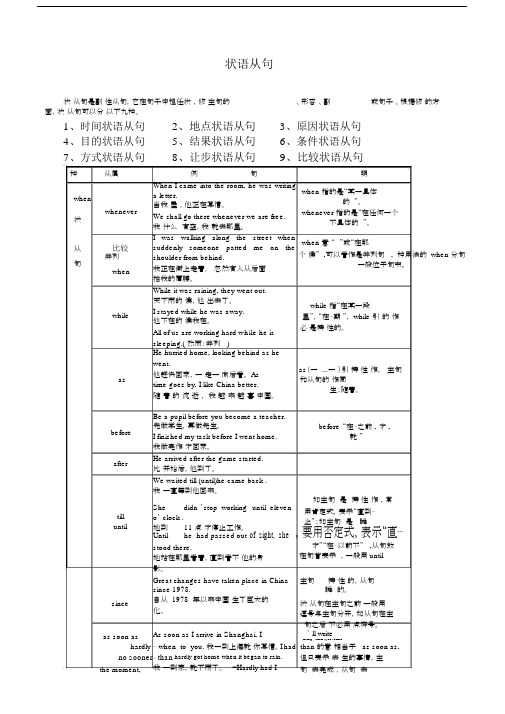
状语从句状从句是副性从句,它在句子中担任状,修主句的、形容、副或句子。
根据修的方面,状从句可以分以下九种。
1、时间状语从句4、目的状语从句7、方式状语从句种从属2、地点状语从句3、原因状语从句5、结果状语从句6、条件状语从句8、让步状语从句9、比较状语从句例句明whenwhenever 状从比较并列句when When I came into the room, he was writinga letter.当我屋,他正在写信。
We shall go there whenever we are free.我什么有空,我就去那里。
I was walking along the street whensuddenly someone patted me on theshoulder from behind.我正在街上走着,忽然有人从后面拍我的肩膀。
when 指的是“某一具体的”。
whenever 指的是“在任何一个不具体的”。
when 意“ ”或“在那个候” ,可以看作是并列句 , 种用法的 when 分句一般位于句末。
while as before While it was raining, they went out.天下雨的候,他出去了。
I stayed while he was away.他不在的候我在。
All of us are working hard while he issleeping.( 然而:并列 )He hurried home, looking behind as hewent.他赶快回家,一走一向后看。
Astime goes by, I like China better.随着的流逝,我越来越喜中国。
Be a pupil before you become a teacher.先做学生,再做先生。
I finished my task before I went home.我做完作才回家。
状语从句表格

Wherever you go, you must obey the law.
无论你去哪都要遵守法律。
where与wherever意义基本相同,但后者语气较强,多用于书面语。
原
因
状
语
从
句
because
I came back late yesterday because I was on duty.
directly,
instantly
As soon as I arrive in Shanghai, I’ll write to you.我一到上海就给你写信。I had hardly got home when it began to rain.
我刚一到家,就下雨了。=Hardly had I got home when it began to rain.
自从1978年以来中国发生了巨大的变化。
主句动词应为持续性的,从句动词为瞬间的。
状语从句在主句之前时一般用逗号与主句分开,如从句在主句之后则不必用标点符号。
as soon as
hardly…when
no sooner…than
the moment,
the instant,
the second,
immediately,
whenever指的是“在任何一个不具体的时间”。
比较
并列连词
when
I was walking along the street when suddenly someone patted me on the shoulder from behind.
我正在街上走着,这时忽然有人从后面拍我的肩膀。
when意为“这时”或“在那个时候”,可以看作是并列句,这种用法的when分句一般位于句末。
状语从句连词表格

Hardly had sb. done sth.+when/before... ; No sooner had sb. done sth. +than...
when, whenever, while, as soon as, 2.since 引导的从句注意看动词是瞬间动词还是延续性动词.
hardly(scarcely) … when,
so that 也可以引导结果状语从句“以至于...” 注意分清 if 从句中是否该用虚拟语气. only if 位于句首,主句倒装
Henry is not such a good worker as Peter .
;..
.
让步状语 though, although, even though,
as 引导的让步状语从句要倒装;though 引导的让步状语从句可以倒装也可以不倒装
Since 句型: It is /has been+time since sb+过去时态
3.when 引导的从句注意其特殊用法.
No sooner … than, the time (moment, instant, was about to do/was on the point of doing/was doing/had (not) done+when(就在那时)...
The six blind men had never seen an elephant, for they were blind.(非常明显的原因) so…that 和 such...that 中的 so 或 such 在句首,主句要部分倒装. So+形容词/副词+半倒装+that...
目的状语 从句
高三英语状语从句表格

Wherever you go, you must obey the law.
无论你去哪都要遵守法律。
where与wherever意义基本相同,但后者语气较强,多用于书面语。
原
因
状
语
从
句
because
I came back late yesterday because I was on duty.
while
While it was raining, they went out.
天下雨的时候,他们出去了。
I stayed while he was away.
他不在的时候我在。
All of us are working hardwhilehe is sleeping.(然而:并列连词)
while指“在某一段时间里”,“在…期间”,while引导的动作必须是持续性的。
万一我忘了,请提醒我一下。
So far as I know, the book will be published next month.
据我所知,那本书下月出版。
unless从句的谓语只能用肯定式。unless和if…not同义,unless是书面语,if…not是口语,通常二者可以换用。
条件状语从句中的谓语动词的时态一般要用现在时或过去时代替一般将来时或过去将来时。
并列连词for
As he didn’t know much English, he looked up the word in the dictionary .
由于他英语懂得不多,他在字典中查阅这个单词。
It must have rained last night, for the ground is still wet.昨天一定下过雨,地还湿呢。
状语从句表格
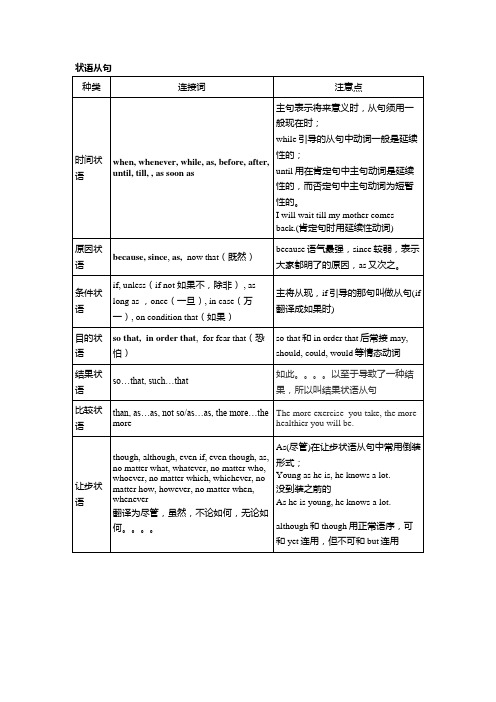
种类r, while, as, before, after, until, till, , as soon as
主句表示将来意义时,从句须用一般现在时;
while引导的从句中动词一般是延续性的;
until用在肯定句中主句动词是延续性的,而否定句中主句动词为短暂性的。
主将从现,if引导的那句叫做从句(if翻译成如果时)
目的状语
so that,in order that,for fear that(恐怕)
so that和in order that后常接may, should, could, would等情态动词
结果状语
so…that, such…that
如此。。。。以至于导致了一种结果,所以叫结果状语从句
翻译为尽管,虽然,不论如何,无论如何。。。。
As(尽管)在让步状语从句中常用倒装形式;
Young as he is, he knows a lot.
没到装之前的
As he is young, he knows a lot.
although和though用正常语序,可和yet连用,但不可和but连用
比较状语
than, as…as, not so/as…as, the more…the more
The more exercise you take, the more healthier you will be.
让步状语
though, although, even if, even though, as, no matter what, whatever, no matter who, whoever, no matter which, whichever, no matter how, however, no matter when, whenever
初中状语从句表格整理

初中状语从句表格整理状语从句是一种副词性从句,用于修饰主句的动词、形容词或副词。
根据修饰的方面,状语从句可以分为九种不同类型。
当表示“当。
时”的状况时,我们可以使用when引导的从句。
例如:“当我进入房间时,他正在写信。
”XXX引导的从句表示“在某一段时间里”或“在。
期间”。
例如:“他们在下雨的时候出去了,而我则一直待在家里。
”使用as引导的从句表示随着时间的推移,某种情况逐渐发生或变化。
例如:“随着时间的推移,我越来越喜欢中国。
”XXX表示“在。
之前”或“才。
”。
例如:“成为一名老师之前,你需要成为一名学生。
”使用after表示“在。
之后”。
例如:“他比赛开始后才到达。
”till或until表示“直到。
为止”,但是要注意主句的动词类型。
如果是持续性动作,我们需要使用肯定式;如果是瞬间动作,我们需要使用否定式。
例如:“我等到他回来才停止工作。
”或者“直到十一点钟,她都没有停止工作。
”状语从句可以帮助我们更加准确地表达自己的意思,使语言更加流畅自然。
因此,在写作或口语中,我们应该尽可能地熟练掌握各种类型的状语从句。
Since 1978.China has XXX。
The verb in the main clause should be continuous。
while the XXX by "since" should have an instantaneous verb。
A comma should be used to separate the subordinate clause from the main clause when the subordinate clause comes before the main clause。
If the subordinate clause comes after the main clause。
XXX needed.As soon as I arrive in Shanghai。
表格“话”状语从句

表格“话”状语从句状语从句是在复合句中充当状语,用来修饰谓语动词、形容词和副词的句子。
状语从句按其意义和作用可以分为时间、地点、原因、条件、结果、方式、让步状语从句等。
在高考中主要考查一下几个方面:①引导状语从句的从属连词;②主从句的时态、语态;③与其他从句和句型的区别;④从句中的省略。
考点例析1.___________ the Internet is bridging the distance between people, it may also be breaking some homes or will cause other family problems.2. The cost of living in Glasgow is among the lowest in Britain, _________ the quality of life is probably one of the highest.3. It was not until near the end of the letter ________ she mentioned her own plan.4. One Friday, we were packing to leave for a weekend away ________ my daughter heard cries for help.5. I have heard a lot of good things about you _________ I came back from abroad.6. ________ I really don‟t like art, I find his work impressive.7. You must learn to consult your feelings and your reasons _________ you reach any decision.表二地点状语从句考点例析1. A number of high buildings have arisen ________ there was nothing a year ago but ruins.2.In peace too, the Red Cross is expected to send help ___________ there is human suffering.3.Everything was placed exactly___________ he wanted it for the graduation ceremony.1.Mark needs to learn Chinese ____________ his company is opening a branch in Beijing.2.He found it increasingly difficult to read, _________ his eyesight was beginning to fail.句型转换He is so young that he can‟t join the army.= He is ________ ___________ __________ join the army.= He is ________ ___________ __________ to join the army.= He is so young __________ ___________ ___________ join the army.表五方式状语从句考点例析考点例析1.I don ‟t believe we ‟ve met before, __________ I must say you do look familiar.2. _____________ I have to give a speech, I get extremely nervous before I start.3. One can always manage to do more things, no matter _____________ full one ‟s schedule is in life.4. —— Look at those clouds!—— Don ‟t worry. __________ it rains, we …ll still have a great time.表八 比较状语从句动词。
状语从句连词表格

where , wherever
后者表示强调.
as, as if/though
as“按照”;“正如”
because, since, as, now (that)
so …that, so that,
such (a)… that, that
语气一个比一个弱;for“因为”,引导的是并列句,表示非常明显的原因或者是作为推测的理由,但它 只能位于句末. It must have rained last night, for the ground is wet.(推测的理由)
so that 也可以引导结果状语从句“以至于...” 注意分清 if 从句中是否该用虚拟语气. only if 位于句首,主句倒装
Henry is not such a good worker as Peter .
.
让步状语 though, although, even though,
从句
as, while(“尽管”,只在句首),
minute, day…),immediately,
4.before 的句型
instantly
It will(not)be +time+before It was (not)+time before
5.not…unt/介词短语/状语从句+半倒装;It was not until+被强调部分+that+句子其它部分
Since 句型: It is /has been+time since sb+过去时态
3.when 引导的从句注意其特殊用法.
No sooner … than, the time (moment, instant, was about to do/was on the point of doing/was doing/had (not) done+when(就在那时)...
初中状语从句表格整理
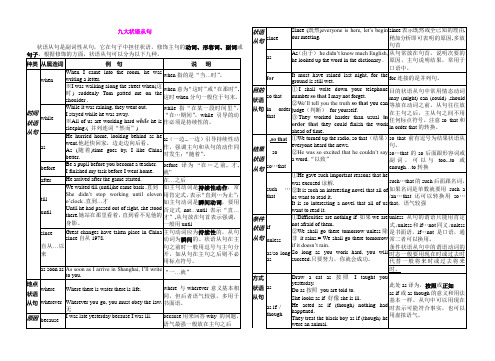
状语从句是副词性从句,它在句子中担任状语,修饰主句的动词、形容词、副词或(1) 当主句是一般将来时、祈使句或主句中含有情态动词,这些词引导的从句要用一般现在时(主将从现)Don ’t go to bed until you finish your homework.(2) when ,while ,as 显然都可以引导时间状语从句,但用法区别非常大。
一、when 可以和延续性动词连用,也可以和短暂性动词连用;而while 和as 只能和延续性动词连用。
① Why do you want a new job when youve got such a good one already ?(get 为短暂性动词)你已经找到如此好的工作,为何还想再找新的? ②Sorry ,I was out when you called me .(call 为短暂性动词) ③Strike while the iron is hot .(is 为延续性动词,表示一种持续的状态)趁热打铁。
④ The students took notes as they listened .(listen 为延续性动词)二、when 从句的谓语动词可以在主句谓语动作之前、之后或同时发生;while 和as 从句的谓语动作必须是和主句谓语动作同时发生。
1.从句动作在主句动作前发生,只用 when 。
①When he had finished his homework ,he took a short rest .(finished 先发生) ②When I got to the airport ,the guests had left .(got to 后发生)2.从句动作和主句动作同时发生,且从句动作为延续性动词时,when ,while ,as 都可使用。
①When /While /As we were dancing ,a stranger came in .(dance 为延续性动词) ②When /While /As she was making a phonecall ,I was writing a letter .(make 为延续性动词)3.当主句、从句动作同时进行,从句动作的时间概念淡化,而主要表示主句动作发生的背景或条件时,只能用 as 。
状语从句表格
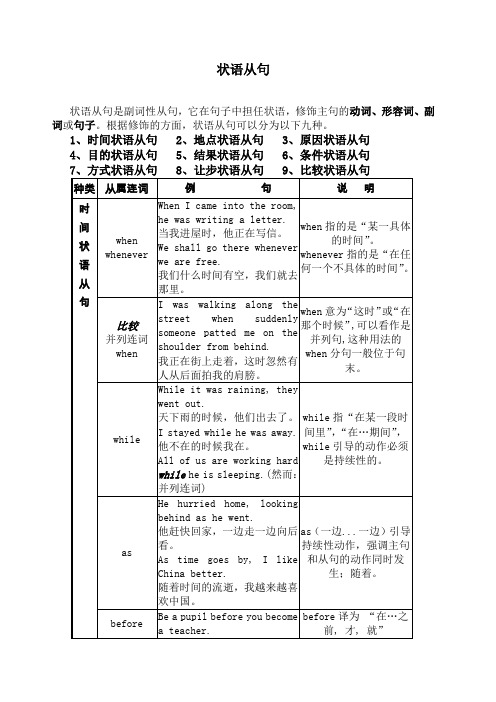
步
状
语
从
句
though
although
Although (Though) he was over sixty, (yet) he began to learn French.
万一我忘了,请提醒我一下。
So far as I know, the book will be published next month.
据我所知,那本书下月出版。
unless从句的谓语只能用肯定式。unless和if…not同义,unless是书面语,if…not是口语,通常二者可以换用。
条件状语从句中的谓语动词的时态一般要用现在时或过去时代替一般将来时或过去将来时。
我把真实情况告诉你,以便你能自己做出判断。
They worked harder than usual in order that they could finish the work ahead of time.
他们比往常更加努力工作,为了能提前完成工作。
Put on more clothes lest (= for fear that ) youshouldcatch cold.
你可以随意到你喜欢的任何地方去。
Wherever you go, you must obey the law.
无论你去哪都要遵守法律。
where与wherever意义基本相同,但后者语气较强,多用于书面语。
原
因
状
语
从
句
because
I came back late yesterday because I was on duty.
Be a pupil before you becomea teacher.
状语从句连词表格

状语从句时状语从句连词引导从句的连词备注after, as, before, once, since, till, until, 1.hardly, no sooner 引导的从句要用过去完成时态,hardly 和 no sooner 在句首时,从句要部分倒装.Hardly had sb. done sth.+when/before... ;No sooner had sb. done sth. +than...间状语从句地点状语从句方式状语从句原因状语从句结果状语从句目的状语从句条件状语从句when,whenever,while,as soon as,hardly(scarcely)⋯ when,No sooner ⋯than, the time (moment, instant,minute, day ⋯ ),immediately,instantlywhere , whereveras, as if/thoughbecause, since, as, now (that)so ⋯ that,such (a)⋯that,so that,thatso that, in order thatif , unless, in case , as/as long as, only if,on (the)condition that,suppose/supposing(that),provided/providing (that)2.since 引导的从句注意看动词是瞬间动词还是延续性动词.Since句型 : It is /has been+time since sb+ 过去时态3.when 引导的从句注意其特殊用法.was about to do/was on the point of doing/was doing/had (not) done+when(就在那时)...4.before 的句型It will ( not ) be +time+before It was (not)+time before5.not ⋯ until 的在倒装句中和强调句中Not until+ 副词 / 介词短语 / 状语从句 +半倒装; It was not until+ 被强调部分 +that+句子其它部分后者表示强调 .as“按照”;“正如”语气一个比一个弱; for“因为”,引导的是并列句,表示非常明显的原因或者是作为推测的理由,但它只能位于句末. It must have rained last night, for the ground is wet. (推测的理由)The six blind men had never seen an elephant, for they were blind. (非常明显的原因)so ⋯ that和 such...that 中的 so 或 such 在句首,主句要部分倒装.So+形容词 / 副词 +半倒装 +that...so that 也可以引导结果状语从句“以至于...”注意分清 if 从句中是否该用虚拟语气.only if 位于句首 ,主句倒装比较状语从句让步状语从句as ⋯ as ;not so ⋯ as; the same as;such ⋯ as; thanthough, although, even though, as,while (“尽管”,只在句首) , nomatter how/wh-= -everHenry is not such a good worker as Peter .as 引导的让步状语从句要倒装; though 引导的让步状语从句可以倒装也可以不倒装名词 / 形容词 / 副词 / 动词原形 +as/though+ 主语 +谓语, +主句 .。
状语从句表格

状语从句是副词性从句,它在句子中担任状语,修饰主句的动词、形容词、副词或句子。
根注意:时间状语从句(1)当主句是一般将来时、祈使句或主句中含有情态动词,这些词引导的从句要用一般现在时(主将从现)Don’t go to bed until you finish your homework.(2)When while as 的辨析A.相同点:都是“当。
时“不同点:when后用短暂性动词,指时间点,此时该从句的时态是一般现在时或一般过去时,后也可用延续性动词,指时间段,时态通常是进行时。
He was watching Tv when I came back.B.while引导的从句后必须是延续性动词,指时间段,常用进行时Someone knocked at the door while she was cooking.C.as着重指主从句同时发生“一边…一边“As we walked,we talked.(3)since 引导的从句一般用过去时,主句用现在完成时I have learnt English since I was 4 .目的状语和结果状语(1)目的状语从句引导词:so that. in order that从句中常用情态动词。
★so that既可引导目的状语从句,又可引导结果状语从句。
区别这两种从句的办法有两个:1)目的状语从句里往往带有情态动词can, could, may, mightwould等。
2)从意思上看,目的状语从句往往表示的目的很明确。
例如:Speak clearly so that they may understand you. (目的状语从句)Jack is badly ill so that he has to rest. (结果状语从句)(2)结果状语从句引导词:so...that,such...that.(3)so与such的区别①so+形+a/an+名单=such+a/an+形+名单②so+many/much/few/little+形+名(只能用so, 不用such)例如:Soon there were so many deer that they ate up all the wild roses.He has so little time that he can’t go to the cinema with you.③such+形+不可数名词/可数名词复数(4)so...that与too...to和...enough to间转换The apple is so dear that I can’t buy it.=The apple is too dear for me to buy.=The apple isn’t cheap enough for me to buy.。
虚拟语气表格整理
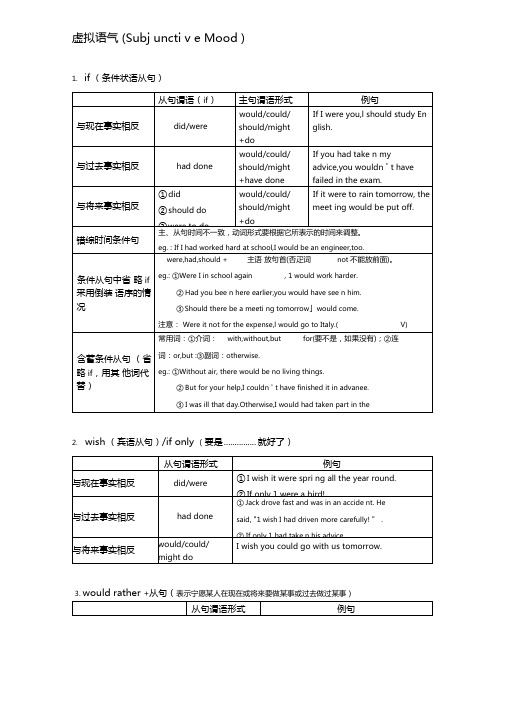
虚拟语气 (Subj uncti v e Mood )1.if (条件状语从句)2.wish (宾语从句)/if only (要是 ............... 就好了)3. would rather +从句(表示宁愿某人在现在或将来要做某事或过去做过某事)4. as if/as though,even if/though + 从句5.在表示“坚持、要求、命令、建议”之类的动词后的宾语从句中,用“(should)+动词原形”6.虚拟语气用于主语从句7.虚拟语气用于表语从句、同位语从句[用(should )+动词原形]8.虚拟语气用于定语从句这种从句常用在It is (high ) time (that )... 句型中,定语从句的谓语动词用过去式或should +动词原形(should 不能省略,be 用were 来表示),意为“(现在)该 【好题珍藏】1.Grace doesn ' t want to move to New York because she thinks if she there, ______________________ she wouldn ' t be able to see her parents very often. ( Pano M6 P16:15)A.livesB.would liveC.has livedD.were to live【解析】主句说明了客观事实,if 从句是对将来事实的假设。
见“ 1.if (条件状语从句)——与将来事实相反”。
【答案】D2」f Mr.Dewey present,he would have offered any possible assista nee to thepeople there.( Pa no M6 P16:16)A.wereB.had bee nC.should beD.was【解析】见“ 1.if (条件状语从句)一一与过去事实相反”。
- 1、下载文档前请自行甄别文档内容的完整性,平台不提供额外的编辑、内容补充、找答案等附加服务。
- 2、"仅部分预览"的文档,不可在线预览部分如存在完整性等问题,可反馈申请退款(可完整预览的文档不适用该条件!)。
- 3、如文档侵犯您的权益,请联系客服反馈,我们会尽快为您处理(人工客服工作时间:9:00-18:30)。
状语从句状语从句是副词性从句,它在句子中担任状语,修饰主句的动词、形容词、副词或句子。
根据修饰的方面,状语从句可以分为以下九种。
种类从属连词例句要点归纳时间状语从句whenWhen I came into the room, he was writing a letter.when指的是“当…时”。
从句中的动词可表延续性动作,也可表瞬间性动作※I was walking along the street when(这时) suddenly Tompatted me on the shoulder .when意为“这时”或“在那时”,这时when分句一般位于句末。
whileWhile it was raining, they went out.※All of us are working hard while he is sleeping.( 并列连词“然而”)while指“在某一段时间里”,“在…期间”,while引导的动作必须是持续性的。
asHe hurried home, looking behind as he went.他赶快回家,边走边向后看。
As (随着)time goes by, I like China better.as(一边...一边)引导持续性动作,强调主句和从句的动作同时发生;“随着”。
beforeBe a pupil before you become a teacher.I finished my task before I went home.before译为“在…之前, 才, 就”after He arrived after the game started.在…之后tilluntilWe waited till (until)he came back .直到She didn’t stop working until eleven o’clock .直到…才主句谓语动词为延续性,常用肯定式;主句谓语动词为瞬间性,常用否定式,可用before替换since,Great changes have taken place in China since 1978.It’s 8 years since I taught here.其从句通常用一般过去时,主句谓语动词通常用完成时常用于It is /was …since句型as soon as As soon as I arrive in Shanghai, I’ll write to you.No sooner had he reached home than it began to rain“一…就”同:i mmediately, directly, instantly, the minute / moment ,no sooner…than, hardly (scarcely)…whenthe firsttimeThe first time I saw him, he was a school teacher同理:every time, each time, any time ,the last time, by the time可引导时间状语从句地点状语从句wherewhereverWhere there is water there is life.Wherever you go, you must obey the law.where与wherever意义基本相同,但后者语气较强。
in which只在定语从句中的某些情况下,才可以与where替换原因状语从句because I was late yesterday because I was ill.because用来回答why 的问题,语气最强一般放在主句之后since Since (既然)everyone is here, let’s begin our meeting.since表示既然或全已知的理由,稍加分析即可表明的原因,多放句首as As(由于) he didn’t know m uch E nglish, he looked up the wordin the dictionary .从句常放在句首,说明次要的原因,主句说明结果,常用于口语中。
for It must have rained last night, for the ground is still wet.for连接的是并列句,表补充说明的原因,常位于主句后。
目的状语从句so thatin orderthat①I shall write down your telephone number so that I may notforget.②They worked harder i n order that they could finish the workahead of time.常用情态动词can (could)等放在从句动词之前,从句往往放在主句之后.in case,for fearthat, lestTake your umbrella in case(以防,以免,唯恐)it should rain.引导的从句可用虚拟语气:should+动词原形;结果状语从句so that;so…that①We turned up the radio, so that everyone heard the news.②He was so excited that he couldn’t say a word.so that前有逗号为结果状语从句。
so…that的so后面跟形容词或副词.such…that①It is such an interesting novel that all of us want to readit.② It is so interesting a novel that all of us want to readit.such…that的such后面跟名词,如果名词是单数就要用such a /an…that还可以转换用so…that,语气较强条件状语从句ifunlessas/so longas①Difficulties are nothing if we are not afraid of them.②We s hall go there tomorrow unless除非 it rains.= We s hallgo there tomorrow if it doesn’t rain.So long as you work hard, you will succeed.只要努力,你就会成功。
unless从句的谓语只能用肯定式。
unless和if…not同义。
条件状语从句中的谓语动词的时态一般要用现在时或过去时代替一般将来时或过去将来时。
once一旦onconditionthatYou may borrow the book, on condition that you donot lend it to anyone else.在……条件下,倘若……supposing假如,如果。
同:suppose that, provided / providing (that)方式状语从句asas if/thoughDraw a cat as I taught you yesterday.She looks as if she is ill.He acted as if (though) nothing had happened.此处as译为,按照或正如as if或as though的意义和用法基本一样。
从句中可以用现在时表示可能符合事实,也可以用虚拟语气。
让步状语从句thoughalthough①Although (Though) he was over sixty, (yet) he began tolearn French.②We w ere not tired though (although) we had worked all day.一般用了“虽然”就不能再用“但是”(but), 但可以与yet或still连用。
though / although意义相同,后者正式多放主句的前面。
even if/thoughI’ll go even if (though) it rains tomorrow.“即使”asChild as he is , he knows a lot .Try as he might, he failed.Cold as it is, (= Though it is cold,)the children playoutdoors.as引出的状语从句常放在句首,语序部分倒装。
虽然,尽管while While I find there are problems, I don’t know what they are.虽然,尽管no matter…Do it no matter what others say.No matter how busy he was, he studied English every day.no matter……与 wh-ever引导的让步状语从句意义一样,但前者不能引导名词性从句。
wh-everWhatever happens / may happen , we shall not lose heart.Whoever comes, he will be glad.as…as Mary is as old as my sister.连词表示同程度级的比较,肯定句用as…as否定句可用not as (so)…as比较状语从句not so/as…asHe doesn’t run so (as) fast as Jack (does).than He bought fewer books than I (did).主句中用比较级的形容词或副词。
the more…the moreThe more you read, the better you understand.The warmer, the better.越暖和越好。
越…越….。
